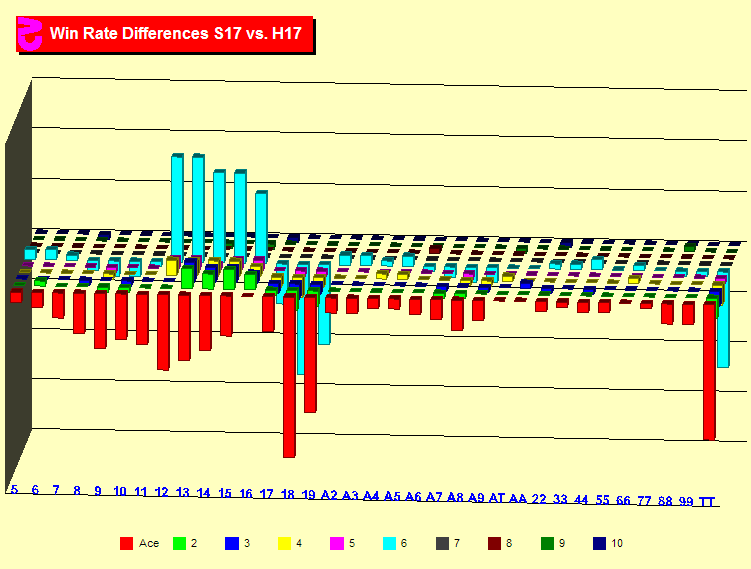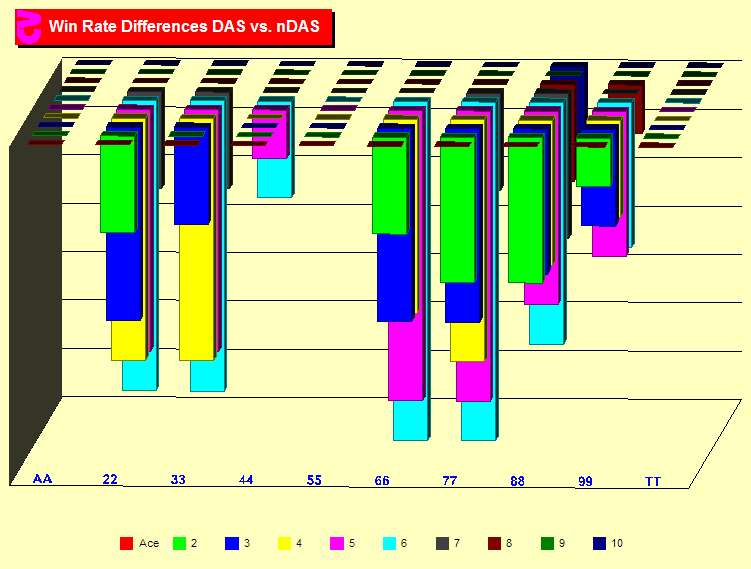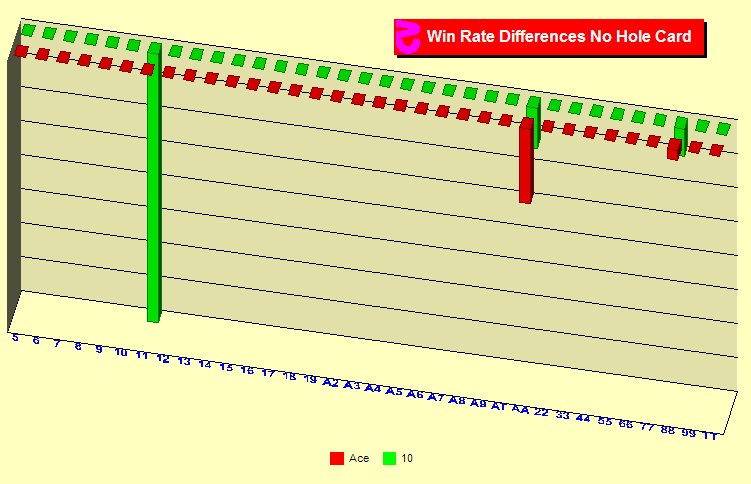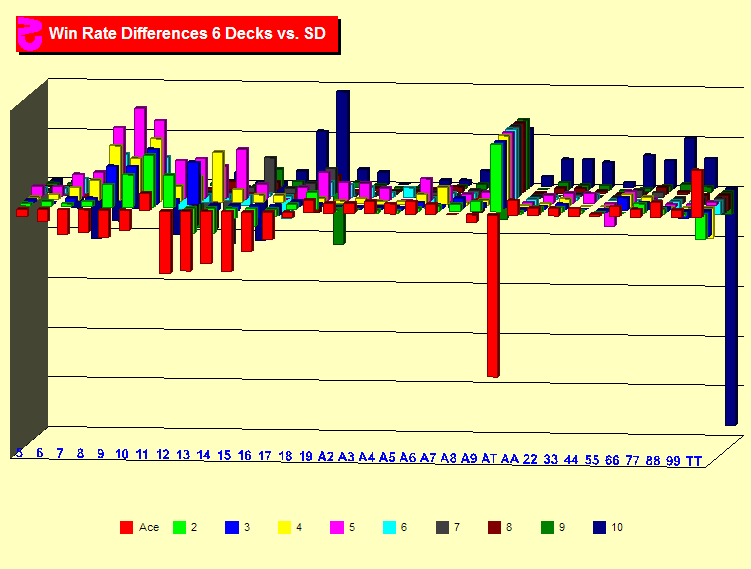|
|
Effects of Blackjack Rules
 What's
the effect of Hit on 17? What's
the effect of Hit on 17?
There are plenty of discussions on the differences in advantage
of common rules. Although most of them are for Basic Strategy only.
Here you will see where the rules make a difference for a better
understanding of the rules. Each of the charts on this page shows
the change in advantage for each of the possible hands caused by
a rule change. For example, this chart shows the difference between
dealer hits soft-17 (H17) and dealer stands on soft-17 (S17). The
H17 rule helps some hands, but hurts more. Wherever you see a bar
point up, the hand has a higher advantage with H17. Where you see
the bar point down, H17 hurts the hand. The red bars are hands where
the dealer has an ace. H17 is bad news in these cases because the
dealer has a soft hand and a second chance to improve a soft-17.
Note the long red bar at player 18 vs. dealer A. You have an 18
and the dealer has a soft hand. If the dealer has a soft-17 he would
normally be stuck with it but with H17 has another chance to beat
your hand. Now look at the cyan (light blue) bars. These are dealer
upcard of six and are better for you with H17 against stiff hands
(12-16). This is because you will stand with this hand and hope
that the dealer busts. The dealer is more likely to bust with H17.
On the other hands, 17-20 versus dealer six are worse with H17 since
the dealer gets an extra chance to beat you if he has an ace in
the hole.
|
|
 What's
the effect of DAS? What's
the effect of DAS?
The Double after Split rule only affects hands that can be Split.
Therefore in this chart only the Pairs are displayed. A bar pointed
downward means the hand has a higher advantage with DAS. There are
no hands that DAS hurts. The cyan bars indicate dealer upcard of
six and see the largest gain. Hands with a dealer upcard of five
see a bit less of a gain. Fours should be Split only with DAS, but
the gain is quite low and hardly worth the change in Basic Strategy.
However, the gains are much higher for card counters and this fact
is often overlooked when card counters look at the differences in
rules.
|
|
 What's
the effect of ENHC? What's
the effect of ENHC?
European No Hole Card affects only a few hands using Basic Strategy.
Possibly a couple more with card counting. The effect is due to
the fact that the player will lose both bets when doubling or splitting
and the dealer has a Blackjack. Only player hands of 11, ace,ace
and 8,8 are affected and the effect is always negative. The largest
effect by far is with 11vTen as you should not double this hand
with ENHC. This is why a card counter may want to use an index for
11vTen to help reduce the negative effect of ENHC.
|
|
 What's
the effect of number of decks? What's
the effect of number of decks?
The difference between single-deck and six decks is much more dramatic.
I have often said the single-deck is a very different game. Wherever
you see a bar pointing up, that hand is responsible for more gain
in single-deck than in six decks. The long, downward red bar is
player BJ against dealer ace. This hand is less valuable in single-deck
because it is less likely that the player will have a Blackjack
if the dealer has an ace in single-deck. However, you will see a
row of upward bars behind the red, downward bar. This is because
player Blackjacks occur more often with single-deck. So, Blackjacks
are more valuable in single-deck if the dealer does not have an
ace and less valuable if the dealer does have an ace. Overall, BJs
are more valuable in single-deck. The longest downward bar is the
dark blue bar for TTvsT. A 20 against a dealer ten is a positive
expectation hand. But it occurs less often in single-deck making
it substantially less valuable. Single-deck sees a higher win rate
in hands 9, 10 and 11 particularly against a dealer 5 because both
the frequency and advantage is higher in single-deck. Overall single-deck
is better than six decks given the same rules — but as you
can see the effect of specific hands varies greatly.
|
|
Sim details
- Six decks, S17, DAS, LS, Heads-Up, Basic Strategy, 75% Penetration
- Six decks, H17, DAS, LS, Heads-Up, Basic Strategy, 75% Penetration
- Six decks, S17, nDAS, LS Heads-Up, Basic Strategy, 75% Penetration
- Six decks, S17, DAS, LS, ENHC Heads-Up, Basic Strategy, 75%
Penetration
- Single-deck, S17, DAS, LS Heads-Up, Basic Strategy, Six Rounds
- Ten billion rounds each
|
|
|
 What's
the effect of Hit on 17?
What's
the effect of Hit on 17? What's
the effect of DAS?
What's
the effect of DAS? What's
the effect of ENHC?
What's
the effect of ENHC? What's
the effect of number of decks?
What's
the effect of number of decks?